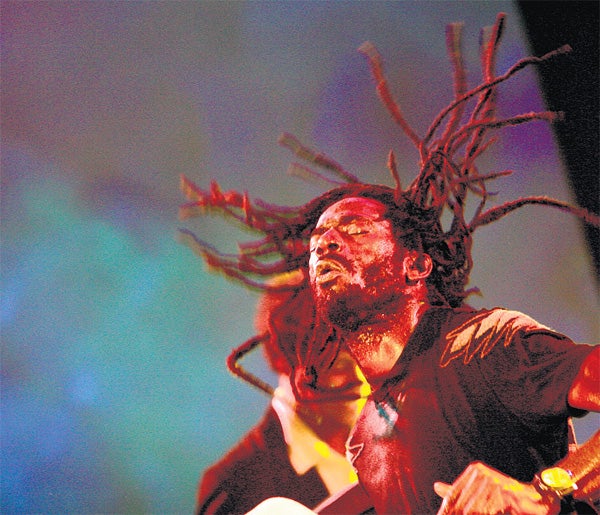Jamaica: Musical notes from a small island
How did tiny Jamaica evolve into such a musical powerhouse? Ian Harrison retraces the history of reggae

One of the outstanding reggae albums of recent times is Alborosie's Soul Pirate, a combination of roughness and finesse that fuses modern and classic Jamaican styles – see 2007's single Kingston Town for proof. It's an appealing incongruity, then, that Alborosie comes from Sicily.
But just as Jamaica has received homage from abroad, this small Caribbean island has sent out extraordinary musical waves across the planet. Take the example of the Jamaican sound system, an outdoor entertainment involving DJs and MCs that went with émigrés to New York and mutated into hip hop. Another innovation was the mixing-desk-as-musical-instrument model of dub, the starting point for remix culture. Reggae, a world class musical powerhouse, has fast-forwarded and rewound through time for inspiration, attuned to its street level constituency and forever on the look out for fresh moves.
With foundation stones including the satirical mento folk style, New Orleans R&B and big band jazz - for a cartoon timeline from country to town to abroad, try the illustrated 12" bag formerly used by Greensleeves records - the reggae story begins in the late 1950s when Kingston soundmen Duke Reid, Prince Buster and Clement 'Coxson' Dodd began recording homegrown talent. The first song with the distinctive reggae rhythm, whose accent falls on the second and fourth beat in the bar, is frequently named as Theophilus Beckford's Easy Snapping from 1958. The music was called ska and was characterised by a brass-driven, jazzy instrumental sound; hundreds of tracks were produced at Coxson's headquarters Studio 1 at Brentford Road, a thoroughfare renamed Studio One Boulevard four days before its owner died of a heart attack on May 5 2004.
The island's independence from Britain in 1962 stimulated the music yet further, with virtuoso group The Skatalites effectively the house band of the ska period. In 1964 Millie Small's My Boy Lollipop, released by Chris Blackwell's burgeoning Island label, brought a smooth version of ska to the American and British charts. In the summer of 1966, received wisdom says, the weather was so sweltering that the ska style had to slow down; rocksteady was born. Soul-indebted and less frenzied, it was a brief affair; in 1968 Lee Perry released the People Funny Boy single, arguably the first example of the modern reggae rhythm.
The seventies would be another decade of innovation, with toasters including the popular-with-punks U-Roy, I Roy and Big Youth refining the MC's role over familiar rhythms. As the seventies drew on, artists such as Burning Spear and Culture would espouse Rastafari philosophies to the sound of roots reggae. As if to escape hard reality that was getting harder, dub commenced when engineering visionary King Tubby, alias Osbourne Ruddock, took instrumental versions of vocal tracks and began otherworldly experimentations with echo, sound effects and elephantine bass. Other distinguished dub albums are the Lee 'Scratch' Perry-produced *Upsetters 14 Dub Blackboard Jungle in 1973 and Augustus Pablo's 1976 LP King Tubby meets Rockers Uptown.
Accompanying roots reggae, global figurehead Bob Marley achieved international success in the seventies, and there is a museum to his life and achievements at his former home at 56 Hope Road in Kingston. Nonetheless, it's worth noting that 1973's Burnin' - the tough, uncompromising sound of the founding Wailers line up of Marley, Peter Tosh and Bunny Livingston – differs from later, more successful releases which were arguably created with the Anglo-American rock audience in mind.
Marley's death in 1981 coincided with another shift in the music's development; led by master populist producer Henry 'Junjo' Lawes, new dancehall sounds overtook Rasta sufferation with songs featuring lighter subject matter. A further leap occurred when former Tubby's initiate King Jammy used a Casio keyboard to produce Wayne Smith's Under Mi Sleng Teng in 1985. A revolution in dancehall rhythms followed – bad news for studio du jour Channel One on Maxfield Avenue, Kingston 13 - leading to the synthesised ragga style. Fears that rude "slackness" lyrics would overwhelm reggae's spiritual side would prove unfounded, with a rearguard action mounted by such neo-roots artists as Luciano, Anthony B and Sizzla.
There is, of course continuing controversy about the latter singer's attitudes to homosexuality. Add this to other challenges of recent years, like the decline of the formerly all-important vinyl single, and even the most rabid reggae head would admit that the music's been in better shape. Interested parties can decide for themselves at Reggae Sumfest, an annual festival in Montego Bay featuring local and international performers, or by watching the non-name musicians who play reggae in Negril on the island's north coast. For the fussier fan the yearly Rebel Salute festival attracts performers including old stagers Horace Andy, John Holt and Gregory Isaacs plus newer performers Tarrus Riley and Lady G. As the late, great Coxson himself said, reggae was always for dancehalls, and as long as people want to dance, so it will continue.
Subscribe to Independent Premium to bookmark this article
Want to bookmark your favourite articles and stories to read or reference later? Start your Independent Premium subscription today.

Join our commenting forum
Join thought-provoking conversations, follow other Independent readers and see their replies